UGB223 Business Finance: Financial Viability & Investment Appraisal
VerifiedAdded on 2023/06/18
|18
|3908
|473
Report
AI Summary
This report provides a comprehensive analysis of investment appraisal techniques and cash cycle management within the context of business finance. It includes calculations of Net Present Value (NPV) and Internal Rate of Return (IRR) for a proposed project, assessing its financial viability for Braithwaite plc. The report also compares different investment appraisal methods, highlighting their strengths and weaknesses. Furthermore, it examines Ramsworth Ltd.'s liquidity position through the calculation of the average operating cash cycle, current ratio, and acid-test ratio, and discusses the potential cost and risk reductions associated with inventory reduction strategies. The report also evaluates the options available to an investor holding shares in Mainsbury PLC, considering the implications of a rights issue.
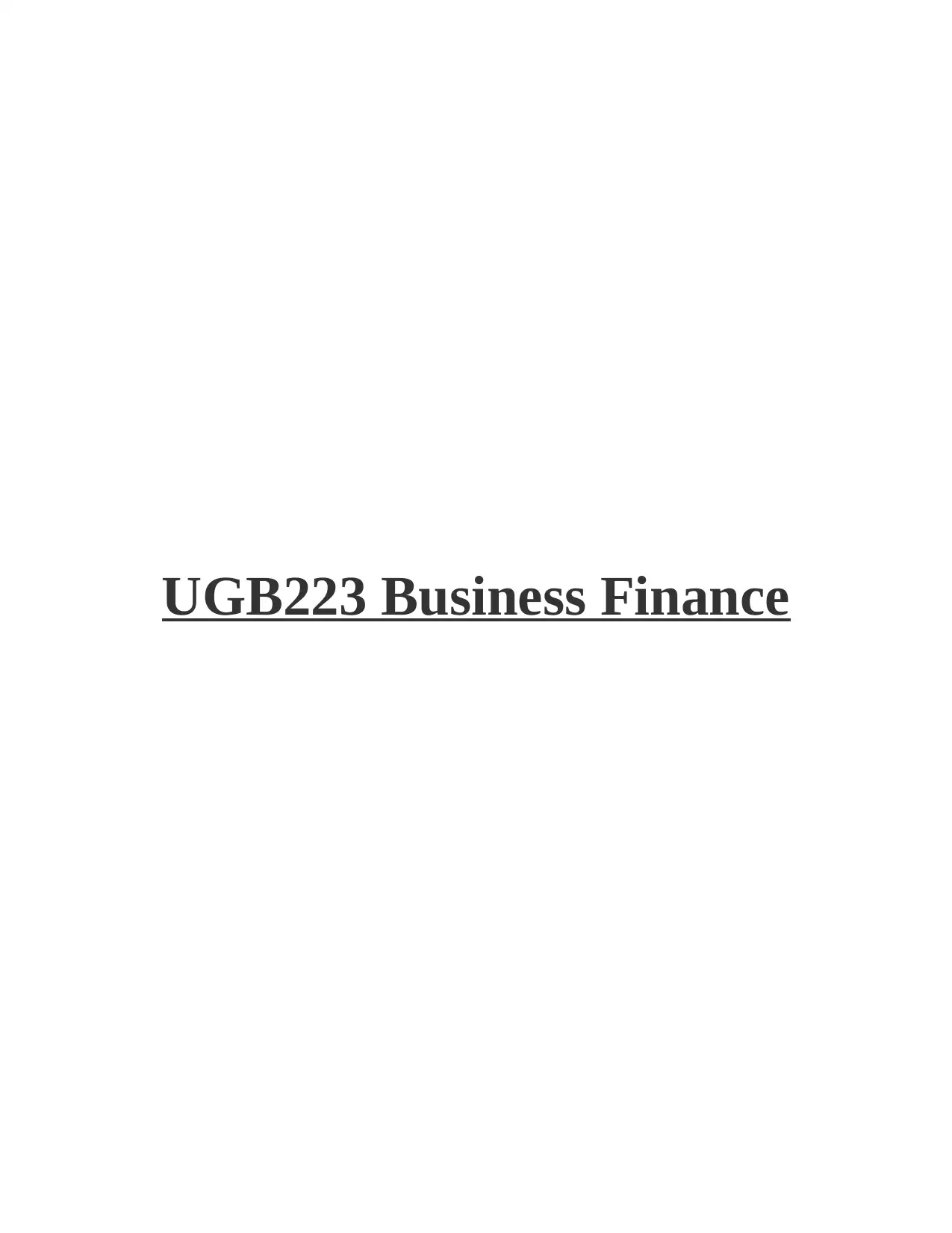
UGB223 Business Finance
Paraphrase This Document
Need a fresh take? Get an instant paraphrase of this document with our AI Paraphraser
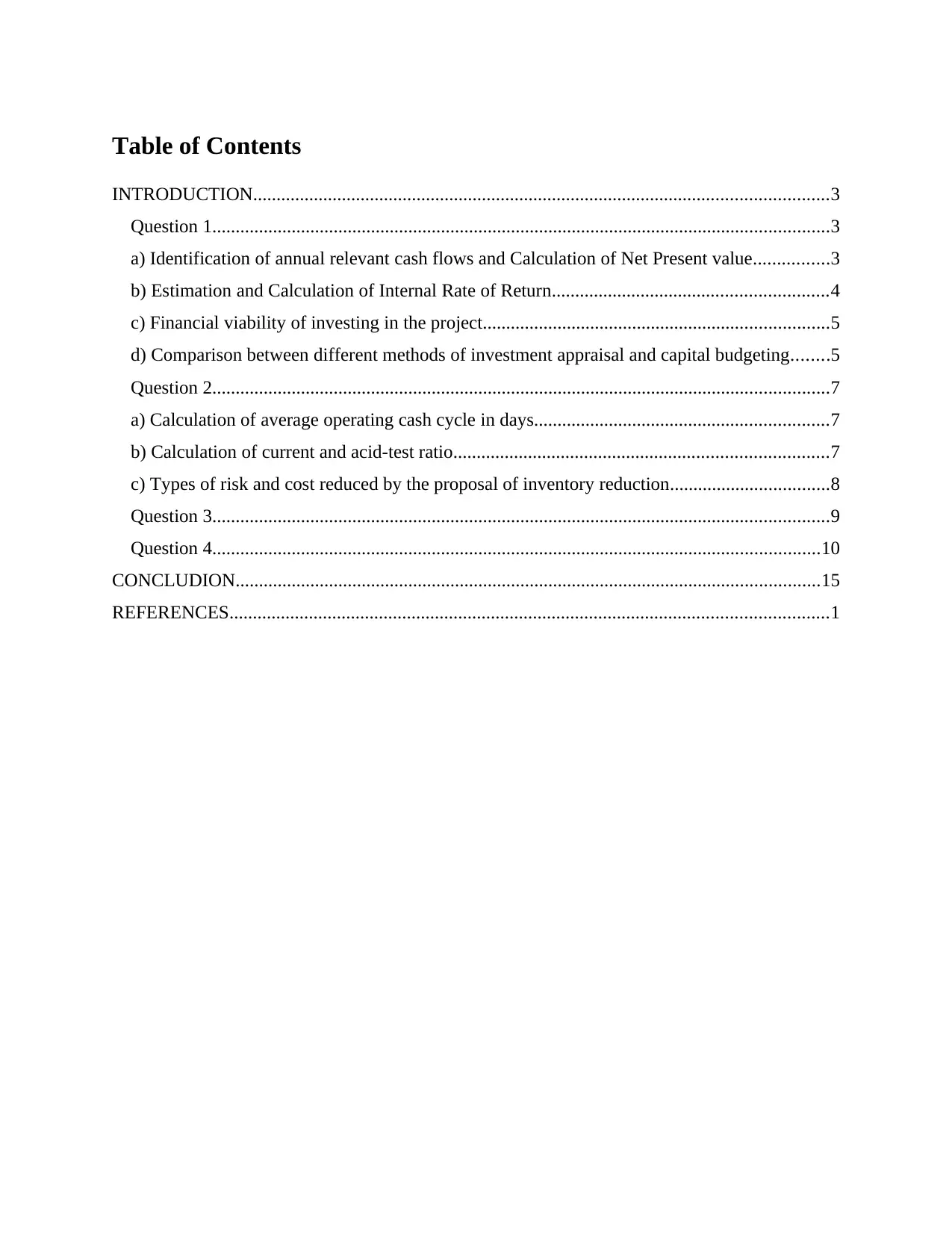
Table of Contents
INTRODUCTION...........................................................................................................................3
Question 1....................................................................................................................................3
a) Identification of annual relevant cash flows and Calculation of Net Present value................3
b) Estimation and Calculation of Internal Rate of Return...........................................................4
c) Financial viability of investing in the project..........................................................................5
d) Comparison between different methods of investment appraisal and capital budgeting........5
Question 2....................................................................................................................................7
a) Calculation of average operating cash cycle in days...............................................................7
b) Calculation of current and acid-test ratio................................................................................7
c) Types of risk and cost reduced by the proposal of inventory reduction..................................8
Question 3....................................................................................................................................9
Question 4..................................................................................................................................10
CONCLUDION.............................................................................................................................15
REFERENCES................................................................................................................................1
INTRODUCTION...........................................................................................................................3
Question 1....................................................................................................................................3
a) Identification of annual relevant cash flows and Calculation of Net Present value................3
b) Estimation and Calculation of Internal Rate of Return...........................................................4
c) Financial viability of investing in the project..........................................................................5
d) Comparison between different methods of investment appraisal and capital budgeting........5
Question 2....................................................................................................................................7
a) Calculation of average operating cash cycle in days...............................................................7
b) Calculation of current and acid-test ratio................................................................................7
c) Types of risk and cost reduced by the proposal of inventory reduction..................................8
Question 3....................................................................................................................................9
Question 4..................................................................................................................................10
CONCLUDION.............................................................................................................................15
REFERENCES................................................................................................................................1
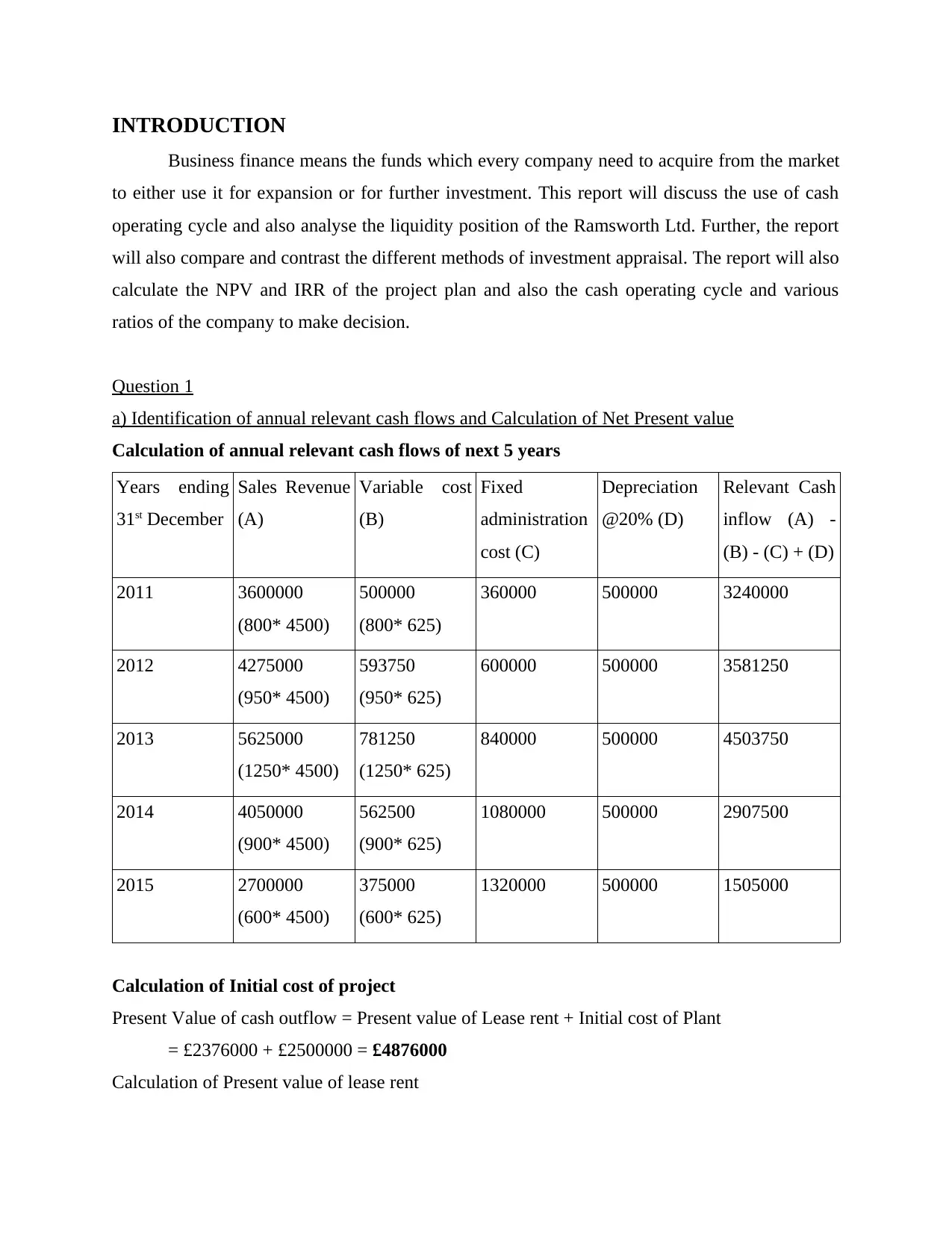
INTRODUCTION
Business finance means the funds which every company need to acquire from the market
to either use it for expansion or for further investment. This report will discuss the use of cash
operating cycle and also analyse the liquidity position of the Ramsworth Ltd. Further, the report
will also compare and contrast the different methods of investment appraisal. The report will also
calculate the NPV and IRR of the project plan and also the cash operating cycle and various
ratios of the company to make decision.
Question 1
a) Identification of annual relevant cash flows and Calculation of Net Present value
Calculation of annual relevant cash flows of next 5 years
Years ending
31st December
Sales Revenue
(A)
Variable cost
(B)
Fixed
administration
cost (C)
Depreciation
@20% (D)
Relevant Cash
inflow (A) -
(B) - (C) + (D)
2011 3600000
(800* 4500)
500000
(800* 625)
360000 500000 3240000
2012 4275000
(950* 4500)
593750
(950* 625)
600000 500000 3581250
2013 5625000
(1250* 4500)
781250
(1250* 625)
840000 500000 4503750
2014 4050000
(900* 4500)
562500
(900* 625)
1080000 500000 2907500
2015 2700000
(600* 4500)
375000
(600* 625)
1320000 500000 1505000
Calculation of Initial cost of project
Present Value of cash outflow = Present value of Lease rent + Initial cost of Plant
= £2376000 + £2500000 = £4876000
Calculation of Present value of lease rent
Business finance means the funds which every company need to acquire from the market
to either use it for expansion or for further investment. This report will discuss the use of cash
operating cycle and also analyse the liquidity position of the Ramsworth Ltd. Further, the report
will also compare and contrast the different methods of investment appraisal. The report will also
calculate the NPV and IRR of the project plan and also the cash operating cycle and various
ratios of the company to make decision.
Question 1
a) Identification of annual relevant cash flows and Calculation of Net Present value
Calculation of annual relevant cash flows of next 5 years
Years ending
31st December
Sales Revenue
(A)
Variable cost
(B)
Fixed
administration
cost (C)
Depreciation
@20% (D)
Relevant Cash
inflow (A) -
(B) - (C) + (D)
2011 3600000
(800* 4500)
500000
(800* 625)
360000 500000 3240000
2012 4275000
(950* 4500)
593750
(950* 625)
600000 500000 3581250
2013 5625000
(1250* 4500)
781250
(1250* 625)
840000 500000 4503750
2014 4050000
(900* 4500)
562500
(900* 625)
1080000 500000 2907500
2015 2700000
(600* 4500)
375000
(600* 625)
1320000 500000 1505000
Calculation of Initial cost of project
Present Value of cash outflow = Present value of Lease rent + Initial cost of Plant
= £2376000 + £2500000 = £4876000
Calculation of Present value of lease rent
⊘ This is a preview!⊘
Do you want full access?
Subscribe today to unlock all pages.

Trusted by 1+ million students worldwide
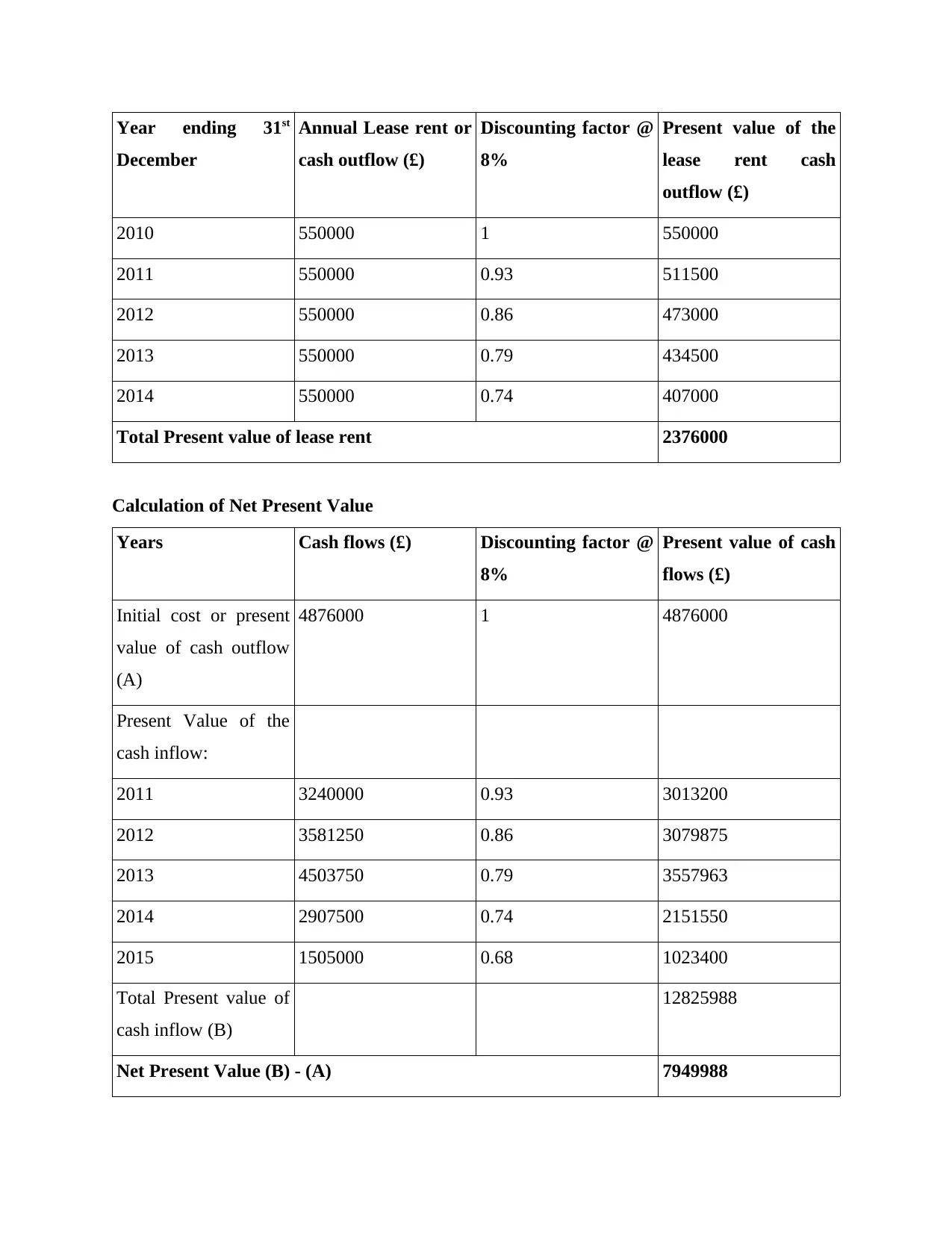
Year ending 31st
December
Annual Lease rent or
cash outflow (£)
Discounting factor @
8%
Present value of the
lease rent cash
outflow (£)
2010 550000 1 550000
2011 550000 0.93 511500
2012 550000 0.86 473000
2013 550000 0.79 434500
2014 550000 0.74 407000
Total Present value of lease rent 2376000
Calculation of Net Present Value
Years Cash flows (£) Discounting factor @
8%
Present value of cash
flows (£)
Initial cost or present
value of cash outflow
(A)
4876000 1 4876000
Present Value of the
cash inflow:
2011 3240000 0.93 3013200
2012 3581250 0.86 3079875
2013 4503750 0.79 3557963
2014 2907500 0.74 2151550
2015 1505000 0.68 1023400
Total Present value of
cash inflow (B)
12825988
Net Present Value (B) - (A) 7949988
December
Annual Lease rent or
cash outflow (£)
Discounting factor @
8%
Present value of the
lease rent cash
outflow (£)
2010 550000 1 550000
2011 550000 0.93 511500
2012 550000 0.86 473000
2013 550000 0.79 434500
2014 550000 0.74 407000
Total Present value of lease rent 2376000
Calculation of Net Present Value
Years Cash flows (£) Discounting factor @
8%
Present value of cash
flows (£)
Initial cost or present
value of cash outflow
(A)
4876000 1 4876000
Present Value of the
cash inflow:
2011 3240000 0.93 3013200
2012 3581250 0.86 3079875
2013 4503750 0.79 3557963
2014 2907500 0.74 2151550
2015 1505000 0.68 1023400
Total Present value of
cash inflow (B)
12825988
Net Present Value (B) - (A) 7949988
Paraphrase This Document
Need a fresh take? Get an instant paraphrase of this document with our AI Paraphraser
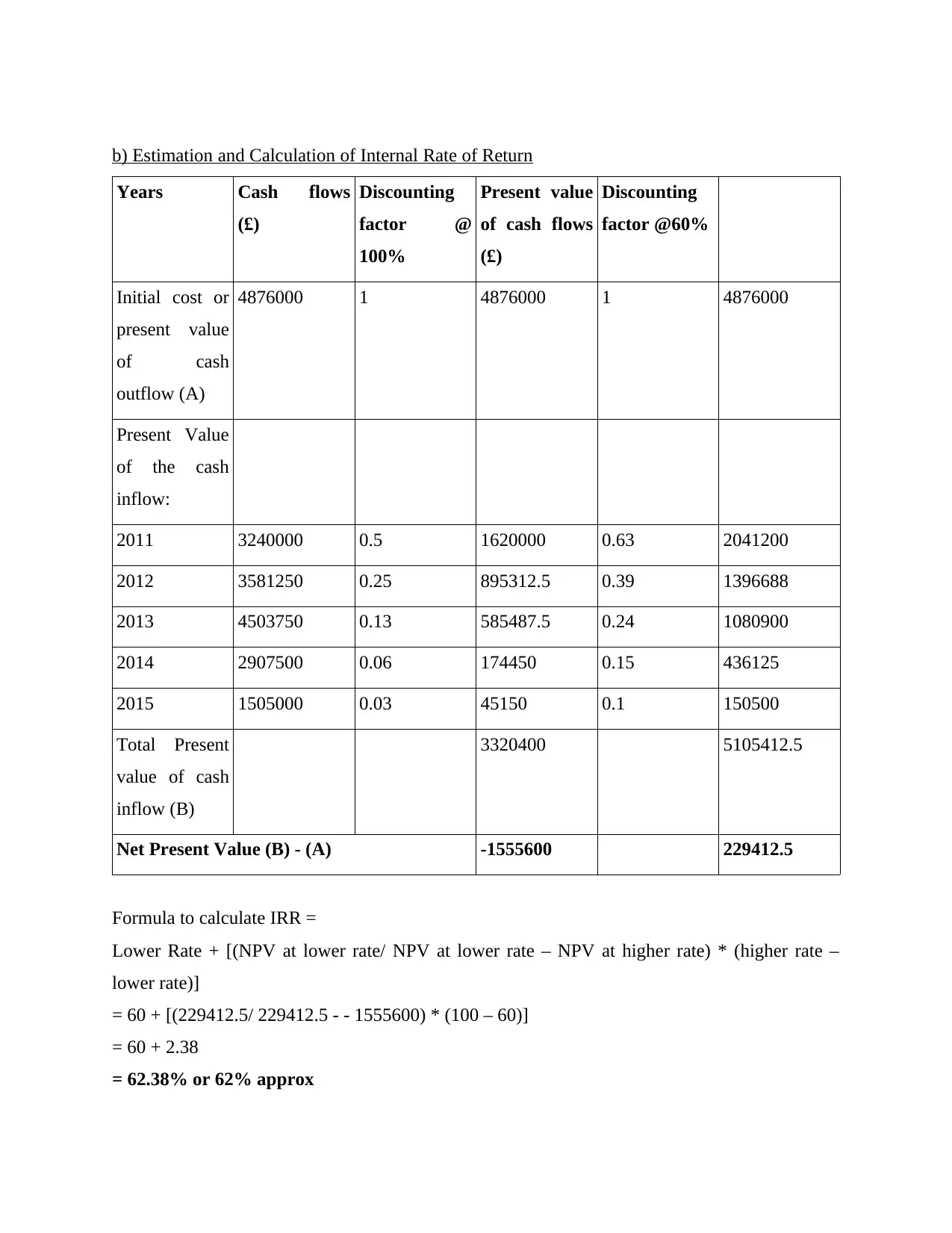
b) Estimation and Calculation of Internal Rate of Return
Years Cash flows
(£)
Discounting
factor @
100%
Present value
of cash flows
(£)
Discounting
factor @60%
Initial cost or
present value
of cash
outflow (A)
4876000 1 4876000 1 4876000
Present Value
of the cash
inflow:
2011 3240000 0.5 1620000 0.63 2041200
2012 3581250 0.25 895312.5 0.39 1396688
2013 4503750 0.13 585487.5 0.24 1080900
2014 2907500 0.06 174450 0.15 436125
2015 1505000 0.03 45150 0.1 150500
Total Present
value of cash
inflow (B)
3320400 5105412.5
Net Present Value (B) - (A) -1555600 229412.5
Formula to calculate IRR =
Lower Rate + [(NPV at lower rate/ NPV at lower rate – NPV at higher rate) * (higher rate –
lower rate)]
= 60 + [(229412.5/ 229412.5 - - 1555600) * (100 – 60)]
= 60 + 2.38
= 62.38% or 62% approx
Years Cash flows
(£)
Discounting
factor @
100%
Present value
of cash flows
(£)
Discounting
factor @60%
Initial cost or
present value
of cash
outflow (A)
4876000 1 4876000 1 4876000
Present Value
of the cash
inflow:
2011 3240000 0.5 1620000 0.63 2041200
2012 3581250 0.25 895312.5 0.39 1396688
2013 4503750 0.13 585487.5 0.24 1080900
2014 2907500 0.06 174450 0.15 436125
2015 1505000 0.03 45150 0.1 150500
Total Present
value of cash
inflow (B)
3320400 5105412.5
Net Present Value (B) - (A) -1555600 229412.5
Formula to calculate IRR =
Lower Rate + [(NPV at lower rate/ NPV at lower rate – NPV at higher rate) * (higher rate –
lower rate)]
= 60 + [(229412.5/ 229412.5 - - 1555600) * (100 – 60)]
= 60 + 2.38
= 62.38% or 62% approx
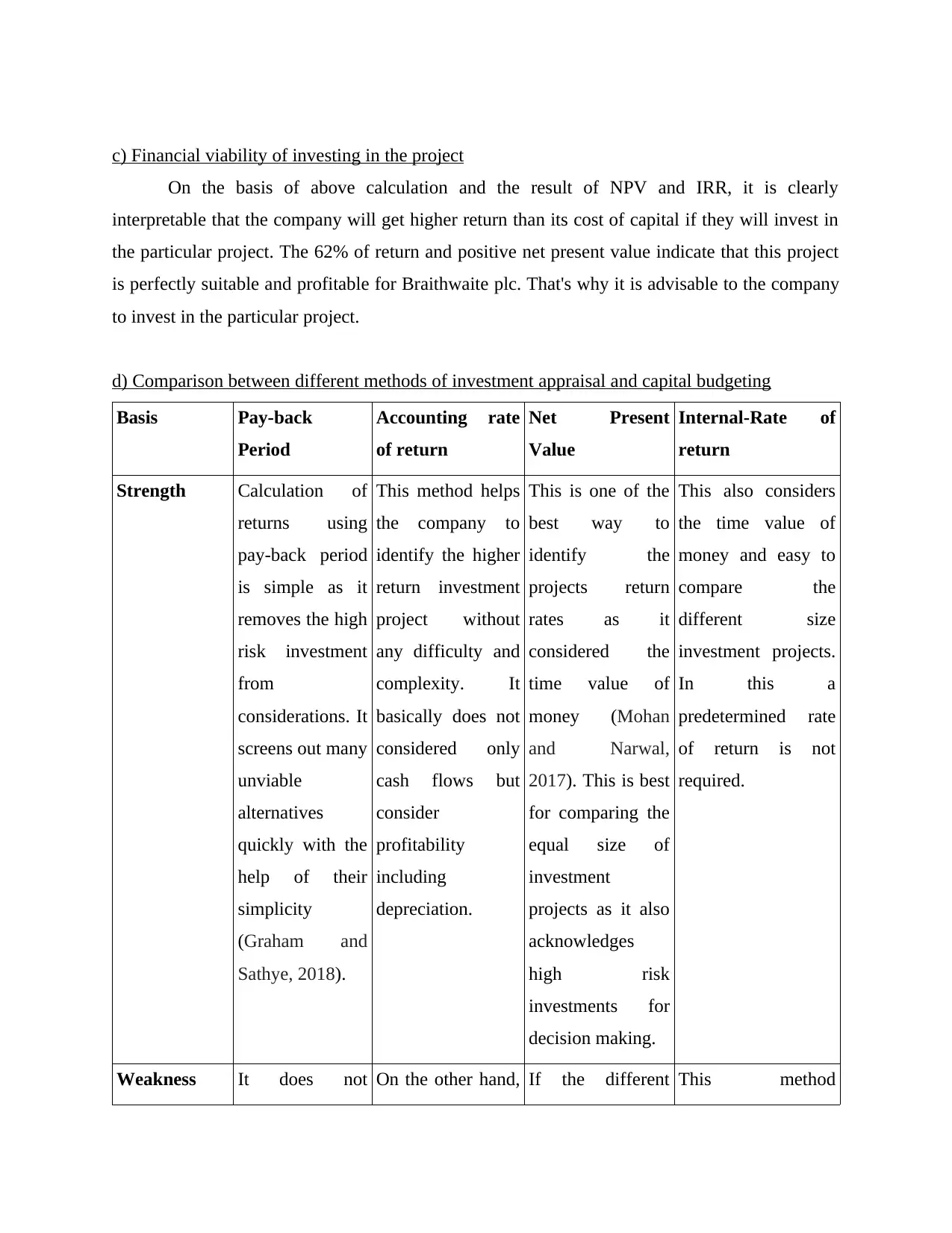
c) Financial viability of investing in the project
On the basis of above calculation and the result of NPV and IRR, it is clearly
interpretable that the company will get higher return than its cost of capital if they will invest in
the particular project. The 62% of return and positive net present value indicate that this project
is perfectly suitable and profitable for Braithwaite plc. That's why it is advisable to the company
to invest in the particular project.
d) Comparison between different methods of investment appraisal and capital budgeting
Basis Pay-back
Period
Accounting rate
of return
Net Present
Value
Internal-Rate of
return
Strength Calculation of
returns using
pay-back period
is simple as it
removes the high
risk investment
from
considerations. It
screens out many
unviable
alternatives
quickly with the
help of their
simplicity
(Graham and
Sathye, 2018).
This method helps
the company to
identify the higher
return investment
project without
any difficulty and
complexity. It
basically does not
considered only
cash flows but
consider
profitability
including
depreciation.
This is one of the
best way to
identify the
projects return
rates as it
considered the
time value of
money (Mohan
and Narwal,
2017). This is best
for comparing the
equal size of
investment
projects as it also
acknowledges
high risk
investments for
decision making.
This also considers
the time value of
money and easy to
compare the
different size
investment projects.
In this a
predetermined rate
of return is not
required.
Weakness It does not On the other hand, If the different This method
On the basis of above calculation and the result of NPV and IRR, it is clearly
interpretable that the company will get higher return than its cost of capital if they will invest in
the particular project. The 62% of return and positive net present value indicate that this project
is perfectly suitable and profitable for Braithwaite plc. That's why it is advisable to the company
to invest in the particular project.
d) Comparison between different methods of investment appraisal and capital budgeting
Basis Pay-back
Period
Accounting rate
of return
Net Present
Value
Internal-Rate of
return
Strength Calculation of
returns using
pay-back period
is simple as it
removes the high
risk investment
from
considerations. It
screens out many
unviable
alternatives
quickly with the
help of their
simplicity
(Graham and
Sathye, 2018).
This method helps
the company to
identify the higher
return investment
project without
any difficulty and
complexity. It
basically does not
considered only
cash flows but
consider
profitability
including
depreciation.
This is one of the
best way to
identify the
projects return
rates as it
considered the
time value of
money (Mohan
and Narwal,
2017). This is best
for comparing the
equal size of
investment
projects as it also
acknowledges
high risk
investments for
decision making.
This also considers
the time value of
money and easy to
compare the
different size
investment projects.
In this a
predetermined rate
of return is not
required.
Weakness It does not On the other hand, If the different This method
⊘ This is a preview!⊘
Do you want full access?
Subscribe today to unlock all pages.

Trusted by 1+ million students worldwide
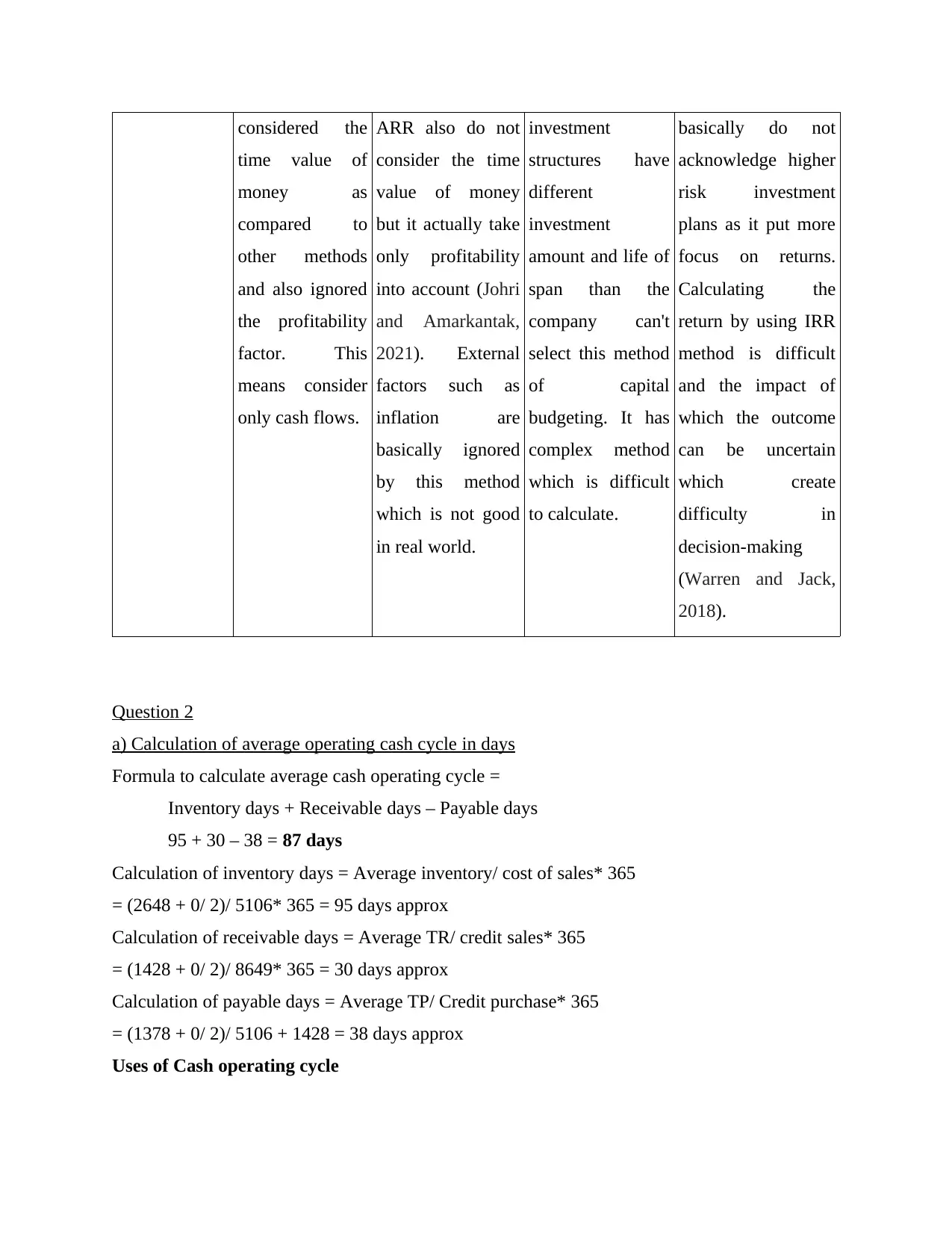
considered the
time value of
money as
compared to
other methods
and also ignored
the profitability
factor. This
means consider
only cash flows.
ARR also do not
consider the time
value of money
but it actually take
only profitability
into account (Johri
and Amarkantak,
2021). External
factors such as
inflation are
basically ignored
by this method
which is not good
in real world.
investment
structures have
different
investment
amount and life of
span than the
company can't
select this method
of capital
budgeting. It has
complex method
which is difficult
to calculate.
basically do not
acknowledge higher
risk investment
plans as it put more
focus on returns.
Calculating the
return by using IRR
method is difficult
and the impact of
which the outcome
can be uncertain
which create
difficulty in
decision-making
(Warren and Jack,
2018).
Question 2
a) Calculation of average operating cash cycle in days
Formula to calculate average cash operating cycle =
Inventory days + Receivable days – Payable days
95 + 30 – 38 = 87 days
Calculation of inventory days = Average inventory/ cost of sales* 365
= (2648 + 0/ 2)/ 5106* 365 = 95 days approx
Calculation of receivable days = Average TR/ credit sales* 365
= (1428 + 0/ 2)/ 8649* 365 = 30 days approx
Calculation of payable days = Average TP/ Credit purchase* 365
= (1378 + 0/ 2)/ 5106 + 1428 = 38 days approx
Uses of Cash operating cycle
time value of
money as
compared to
other methods
and also ignored
the profitability
factor. This
means consider
only cash flows.
ARR also do not
consider the time
value of money
but it actually take
only profitability
into account (Johri
and Amarkantak,
2021). External
factors such as
inflation are
basically ignored
by this method
which is not good
in real world.
investment
structures have
different
investment
amount and life of
span than the
company can't
select this method
of capital
budgeting. It has
complex method
which is difficult
to calculate.
basically do not
acknowledge higher
risk investment
plans as it put more
focus on returns.
Calculating the
return by using IRR
method is difficult
and the impact of
which the outcome
can be uncertain
which create
difficulty in
decision-making
(Warren and Jack,
2018).
Question 2
a) Calculation of average operating cash cycle in days
Formula to calculate average cash operating cycle =
Inventory days + Receivable days – Payable days
95 + 30 – 38 = 87 days
Calculation of inventory days = Average inventory/ cost of sales* 365
= (2648 + 0/ 2)/ 5106* 365 = 95 days approx
Calculation of receivable days = Average TR/ credit sales* 365
= (1428 + 0/ 2)/ 8649* 365 = 30 days approx
Calculation of payable days = Average TP/ Credit purchase* 365
= (1378 + 0/ 2)/ 5106 + 1428 = 38 days approx
Uses of Cash operating cycle
Paraphrase This Document
Need a fresh take? Get an instant paraphrase of this document with our AI Paraphraser
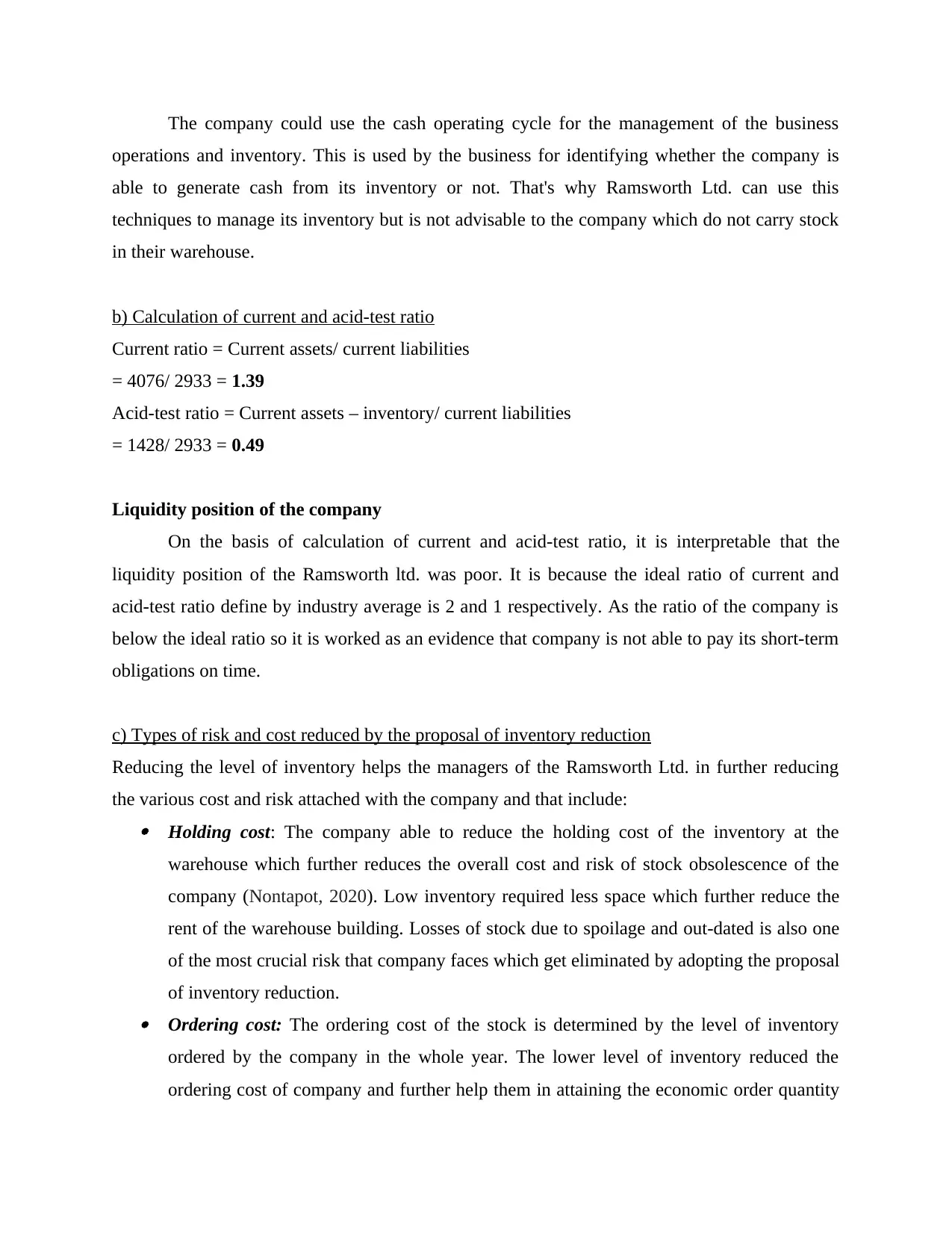
The company could use the cash operating cycle for the management of the business
operations and inventory. This is used by the business for identifying whether the company is
able to generate cash from its inventory or not. That's why Ramsworth Ltd. can use this
techniques to manage its inventory but is not advisable to the company which do not carry stock
in their warehouse.
b) Calculation of current and acid-test ratio
Current ratio = Current assets/ current liabilities
= 4076/ 2933 = 1.39
Acid-test ratio = Current assets – inventory/ current liabilities
= 1428/ 2933 = 0.49
Liquidity position of the company
On the basis of calculation of current and acid-test ratio, it is interpretable that the
liquidity position of the Ramsworth ltd. was poor. It is because the ideal ratio of current and
acid-test ratio define by industry average is 2 and 1 respectively. As the ratio of the company is
below the ideal ratio so it is worked as an evidence that company is not able to pay its short-term
obligations on time.
c) Types of risk and cost reduced by the proposal of inventory reduction
Reducing the level of inventory helps the managers of the Ramsworth Ltd. in further reducing
the various cost and risk attached with the company and that include: Holding cost: The company able to reduce the holding cost of the inventory at the
warehouse which further reduces the overall cost and risk of stock obsolescence of the
company (Nontapot, 2020). Low inventory required less space which further reduce the
rent of the warehouse building. Losses of stock due to spoilage and out-dated is also one
of the most crucial risk that company faces which get eliminated by adopting the proposal
of inventory reduction. Ordering cost: The ordering cost of the stock is determined by the level of inventory
ordered by the company in the whole year. The lower level of inventory reduced the
ordering cost of company and further help them in attaining the economic order quantity
operations and inventory. This is used by the business for identifying whether the company is
able to generate cash from its inventory or not. That's why Ramsworth Ltd. can use this
techniques to manage its inventory but is not advisable to the company which do not carry stock
in their warehouse.
b) Calculation of current and acid-test ratio
Current ratio = Current assets/ current liabilities
= 4076/ 2933 = 1.39
Acid-test ratio = Current assets – inventory/ current liabilities
= 1428/ 2933 = 0.49
Liquidity position of the company
On the basis of calculation of current and acid-test ratio, it is interpretable that the
liquidity position of the Ramsworth ltd. was poor. It is because the ideal ratio of current and
acid-test ratio define by industry average is 2 and 1 respectively. As the ratio of the company is
below the ideal ratio so it is worked as an evidence that company is not able to pay its short-term
obligations on time.
c) Types of risk and cost reduced by the proposal of inventory reduction
Reducing the level of inventory helps the managers of the Ramsworth Ltd. in further reducing
the various cost and risk attached with the company and that include: Holding cost: The company able to reduce the holding cost of the inventory at the
warehouse which further reduces the overall cost and risk of stock obsolescence of the
company (Nontapot, 2020). Low inventory required less space which further reduce the
rent of the warehouse building. Losses of stock due to spoilage and out-dated is also one
of the most crucial risk that company faces which get eliminated by adopting the proposal
of inventory reduction. Ordering cost: The ordering cost of the stock is determined by the level of inventory
ordered by the company in the whole year. The lower level of inventory reduced the
ordering cost of company and further help them in attaining the economic order quantity
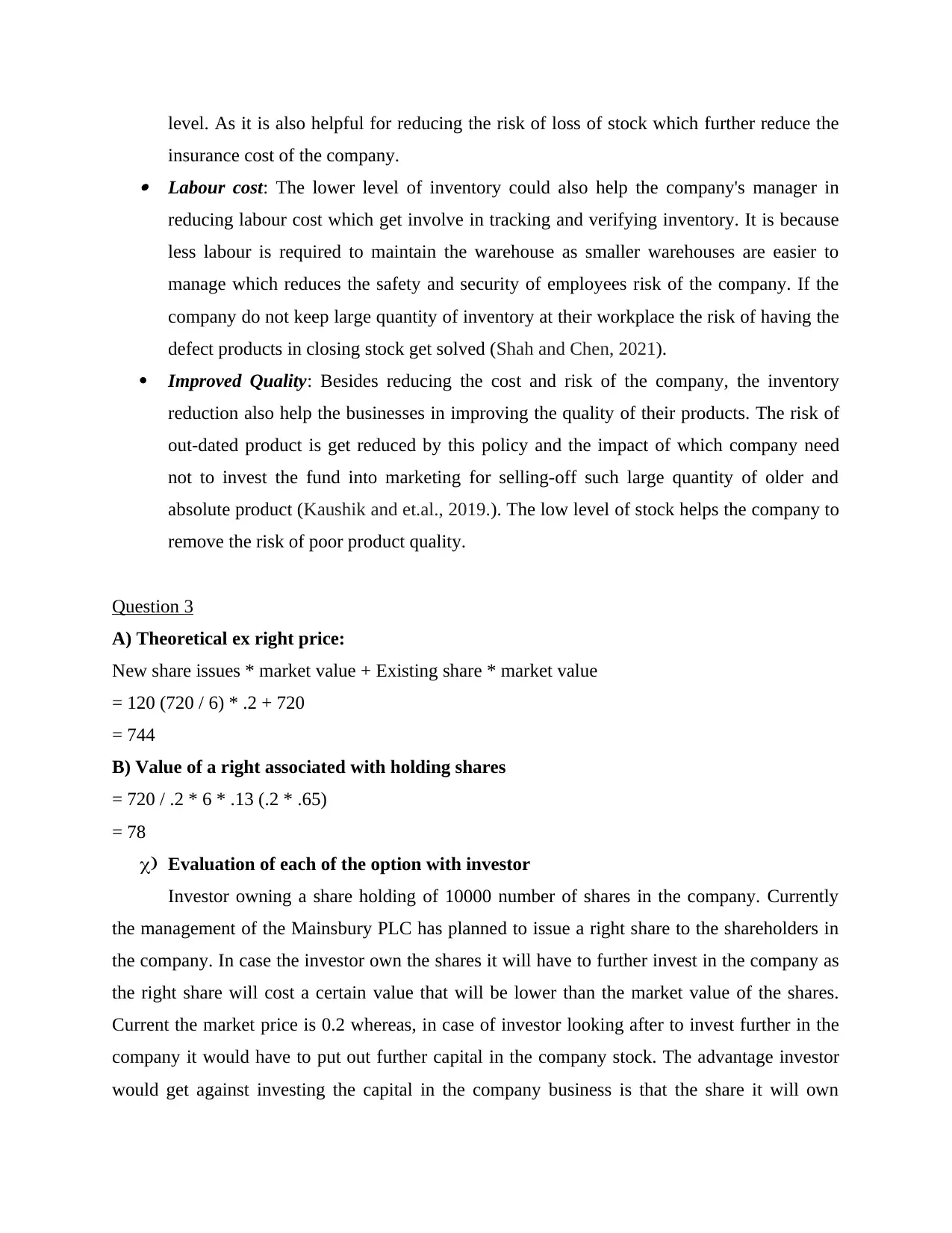
level. As it is also helpful for reducing the risk of loss of stock which further reduce the
insurance cost of the company. Labour cost: The lower level of inventory could also help the company's manager in
reducing labour cost which get involve in tracking and verifying inventory. It is because
less labour is required to maintain the warehouse as smaller warehouses are easier to
manage which reduces the safety and security of employees risk of the company. If the
company do not keep large quantity of inventory at their workplace the risk of having the
defect products in closing stock get solved (Shah and Chen, 2021).
Improved Quality: Besides reducing the cost and risk of the company, the inventory
reduction also help the businesses in improving the quality of their products. The risk of
out-dated product is get reduced by this policy and the impact of which company need
not to invest the fund into marketing for selling-off such large quantity of older and
absolute product (Kaushik and et.al., 2019.). The low level of stock helps the company to
remove the risk of poor product quality.
Question 3
A) Theoretical ex right price:
New share issues * market value + Existing share * market value
= 120 (720 / 6) * .2 + 720
= 744
B) Value of a right associated with holding shares
= 720 / .2 * 6 * .13 (.2 * .65)
= 78
c) Evaluation of each of the option with investor
Investor owning a share holding of 10000 number of shares in the company. Currently
the management of the Mainsbury PLC has planned to issue a right share to the shareholders in
the company. In case the investor own the shares it will have to further invest in the company as
the right share will cost a certain value that will be lower than the market value of the shares.
Current the market price is 0.2 whereas, in case of investor looking after to invest further in the
company it would have to put out further capital in the company stock. The advantage investor
would get against investing the capital in the company business is that the share it will own
insurance cost of the company. Labour cost: The lower level of inventory could also help the company's manager in
reducing labour cost which get involve in tracking and verifying inventory. It is because
less labour is required to maintain the warehouse as smaller warehouses are easier to
manage which reduces the safety and security of employees risk of the company. If the
company do not keep large quantity of inventory at their workplace the risk of having the
defect products in closing stock get solved (Shah and Chen, 2021).
Improved Quality: Besides reducing the cost and risk of the company, the inventory
reduction also help the businesses in improving the quality of their products. The risk of
out-dated product is get reduced by this policy and the impact of which company need
not to invest the fund into marketing for selling-off such large quantity of older and
absolute product (Kaushik and et.al., 2019.). The low level of stock helps the company to
remove the risk of poor product quality.
Question 3
A) Theoretical ex right price:
New share issues * market value + Existing share * market value
= 120 (720 / 6) * .2 + 720
= 744
B) Value of a right associated with holding shares
= 720 / .2 * 6 * .13 (.2 * .65)
= 78
c) Evaluation of each of the option with investor
Investor owning a share holding of 10000 number of shares in the company. Currently
the management of the Mainsbury PLC has planned to issue a right share to the shareholders in
the company. In case the investor own the shares it will have to further invest in the company as
the right share will cost a certain value that will be lower than the market value of the shares.
Current the market price is 0.2 whereas, in case of investor looking after to invest further in the
company it would have to put out further capital in the company stock. The advantage investor
would get against investing the capital in the company business is that the share it will own
⊘ This is a preview!⊘
Do you want full access?
Subscribe today to unlock all pages.

Trusted by 1+ million students worldwide
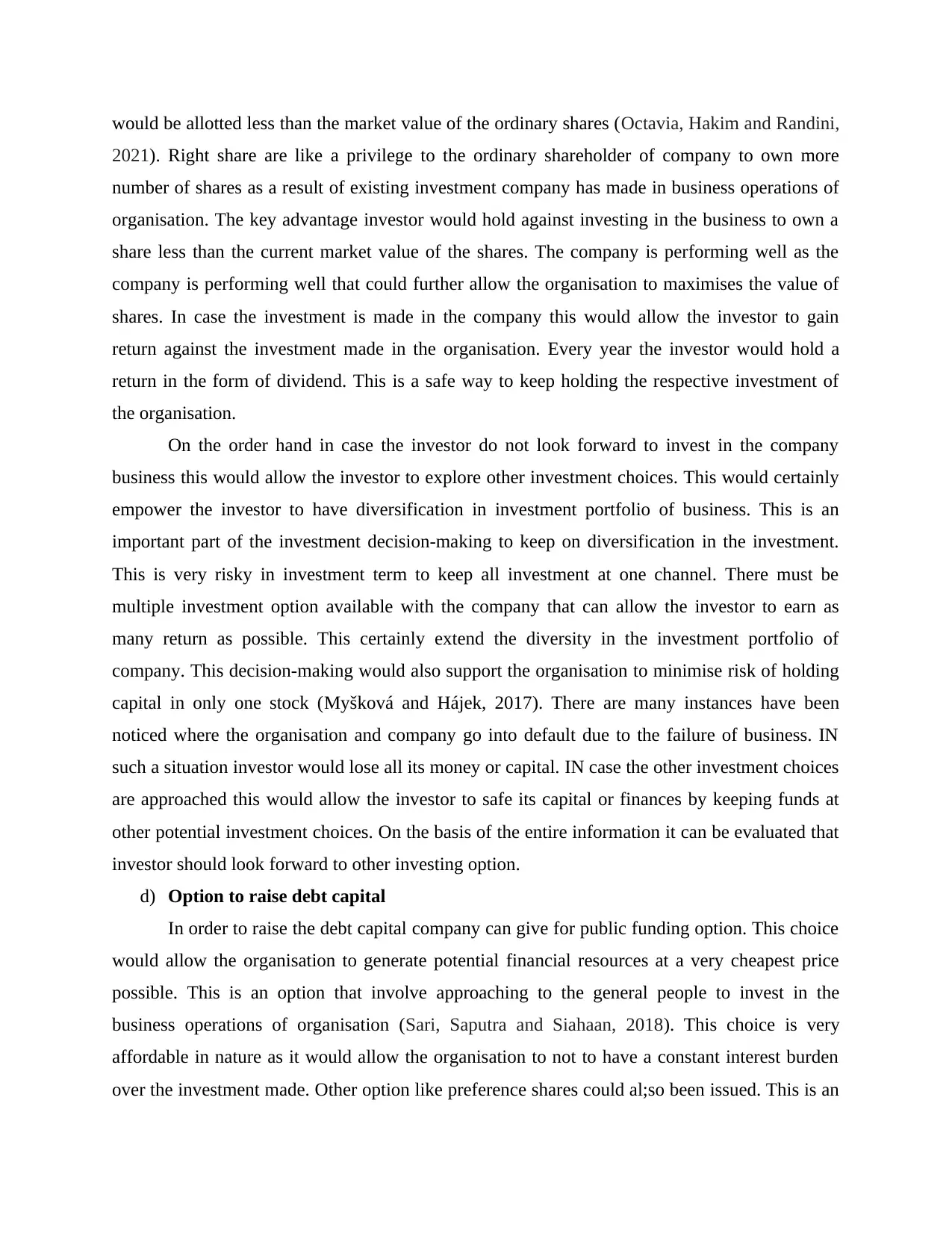
would be allotted less than the market value of the ordinary shares (Octavia, Hakim and Randini,
2021). Right share are like a privilege to the ordinary shareholder of company to own more
number of shares as a result of existing investment company has made in business operations of
organisation. The key advantage investor would hold against investing in the business to own a
share less than the current market value of the shares. The company is performing well as the
company is performing well that could further allow the organisation to maximises the value of
shares. In case the investment is made in the company this would allow the investor to gain
return against the investment made in the organisation. Every year the investor would hold a
return in the form of dividend. This is a safe way to keep holding the respective investment of
the organisation.
On the order hand in case the investor do not look forward to invest in the company
business this would allow the investor to explore other investment choices. This would certainly
empower the investor to have diversification in investment portfolio of business. This is an
important part of the investment decision-making to keep on diversification in the investment.
This is very risky in investment term to keep all investment at one channel. There must be
multiple investment option available with the company that can allow the investor to earn as
many return as possible. This certainly extend the diversity in the investment portfolio of
company. This decision-making would also support the organisation to minimise risk of holding
capital in only one stock (Myšková and Hájek, 2017). There are many instances have been
noticed where the organisation and company go into default due to the failure of business. IN
such a situation investor would lose all its money or capital. IN case the other investment choices
are approached this would allow the investor to safe its capital or finances by keeping funds at
other potential investment choices. On the basis of the entire information it can be evaluated that
investor should look forward to other investing option.
d) Option to raise debt capital
In order to raise the debt capital company can give for public funding option. This choice
would allow the organisation to generate potential financial resources at a very cheapest price
possible. This is an option that involve approaching to the general people to invest in the
business operations of organisation (Sari, Saputra and Siahaan, 2018). This choice is very
affordable in nature as it would allow the organisation to not to have a constant interest burden
over the investment made. Other option like preference shares could al;so been issued. This is an
2021). Right share are like a privilege to the ordinary shareholder of company to own more
number of shares as a result of existing investment company has made in business operations of
organisation. The key advantage investor would hold against investing in the business to own a
share less than the current market value of the shares. The company is performing well as the
company is performing well that could further allow the organisation to maximises the value of
shares. In case the investment is made in the company this would allow the investor to gain
return against the investment made in the organisation. Every year the investor would hold a
return in the form of dividend. This is a safe way to keep holding the respective investment of
the organisation.
On the order hand in case the investor do not look forward to invest in the company
business this would allow the investor to explore other investment choices. This would certainly
empower the investor to have diversification in investment portfolio of business. This is an
important part of the investment decision-making to keep on diversification in the investment.
This is very risky in investment term to keep all investment at one channel. There must be
multiple investment option available with the company that can allow the investor to earn as
many return as possible. This certainly extend the diversity in the investment portfolio of
company. This decision-making would also support the organisation to minimise risk of holding
capital in only one stock (Myšková and Hájek, 2017). There are many instances have been
noticed where the organisation and company go into default due to the failure of business. IN
such a situation investor would lose all its money or capital. IN case the other investment choices
are approached this would allow the investor to safe its capital or finances by keeping funds at
other potential investment choices. On the basis of the entire information it can be evaluated that
investor should look forward to other investing option.
d) Option to raise debt capital
In order to raise the debt capital company can give for public funding option. This choice
would allow the organisation to generate potential financial resources at a very cheapest price
possible. This is an option that involve approaching to the general people to invest in the
business operations of organisation (Sari, Saputra and Siahaan, 2018). This choice is very
affordable in nature as it would allow the organisation to not to have a constant interest burden
over the investment made. Other option like preference shares could al;so been issued. This is an
Paraphrase This Document
Need a fresh take? Get an instant paraphrase of this document with our AI Paraphraser
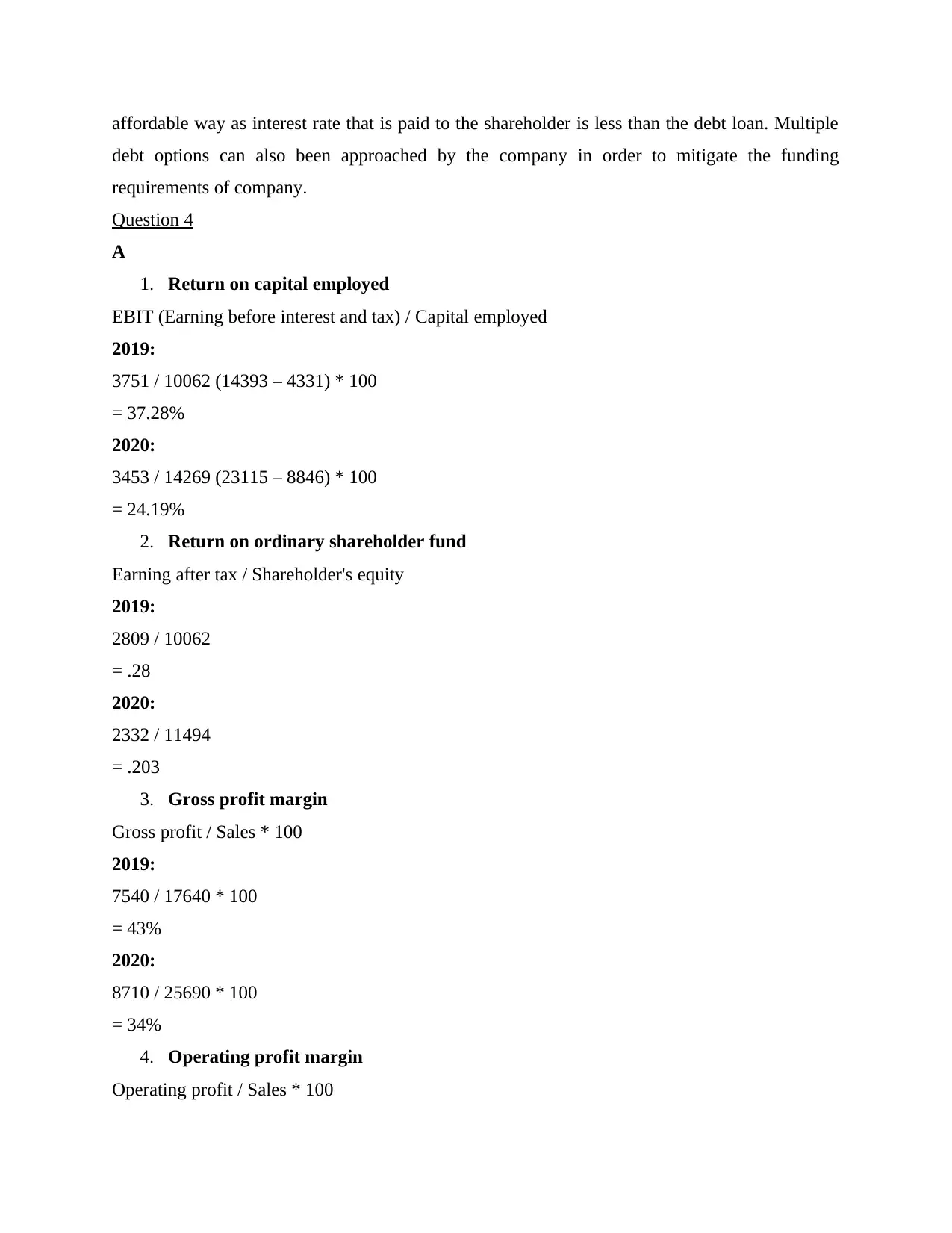
affordable way as interest rate that is paid to the shareholder is less than the debt loan. Multiple
debt options can also been approached by the company in order to mitigate the funding
requirements of company.
Question 4
A
1. Return on capital employed
EBIT (Earning before interest and tax) / Capital employed
2019:
3751 / 10062 (14393 – 4331) * 100
= 37.28%
2020:
3453 / 14269 (23115 – 8846) * 100
= 24.19%
2. Return on ordinary shareholder fund
Earning after tax / Shareholder's equity
2019:
2809 / 10062
= .28
2020:
2332 / 11494
= .203
3. Gross profit margin
Gross profit / Sales * 100
2019:
7540 / 17640 * 100
= 43%
2020:
8710 / 25690 * 100
= 34%
4. Operating profit margin
Operating profit / Sales * 100
debt options can also been approached by the company in order to mitigate the funding
requirements of company.
Question 4
A
1. Return on capital employed
EBIT (Earning before interest and tax) / Capital employed
2019:
3751 / 10062 (14393 – 4331) * 100
= 37.28%
2020:
3453 / 14269 (23115 – 8846) * 100
= 24.19%
2. Return on ordinary shareholder fund
Earning after tax / Shareholder's equity
2019:
2809 / 10062
= .28
2020:
2332 / 11494
= .203
3. Gross profit margin
Gross profit / Sales * 100
2019:
7540 / 17640 * 100
= 43%
2020:
8710 / 25690 * 100
= 34%
4. Operating profit margin
Operating profit / Sales * 100
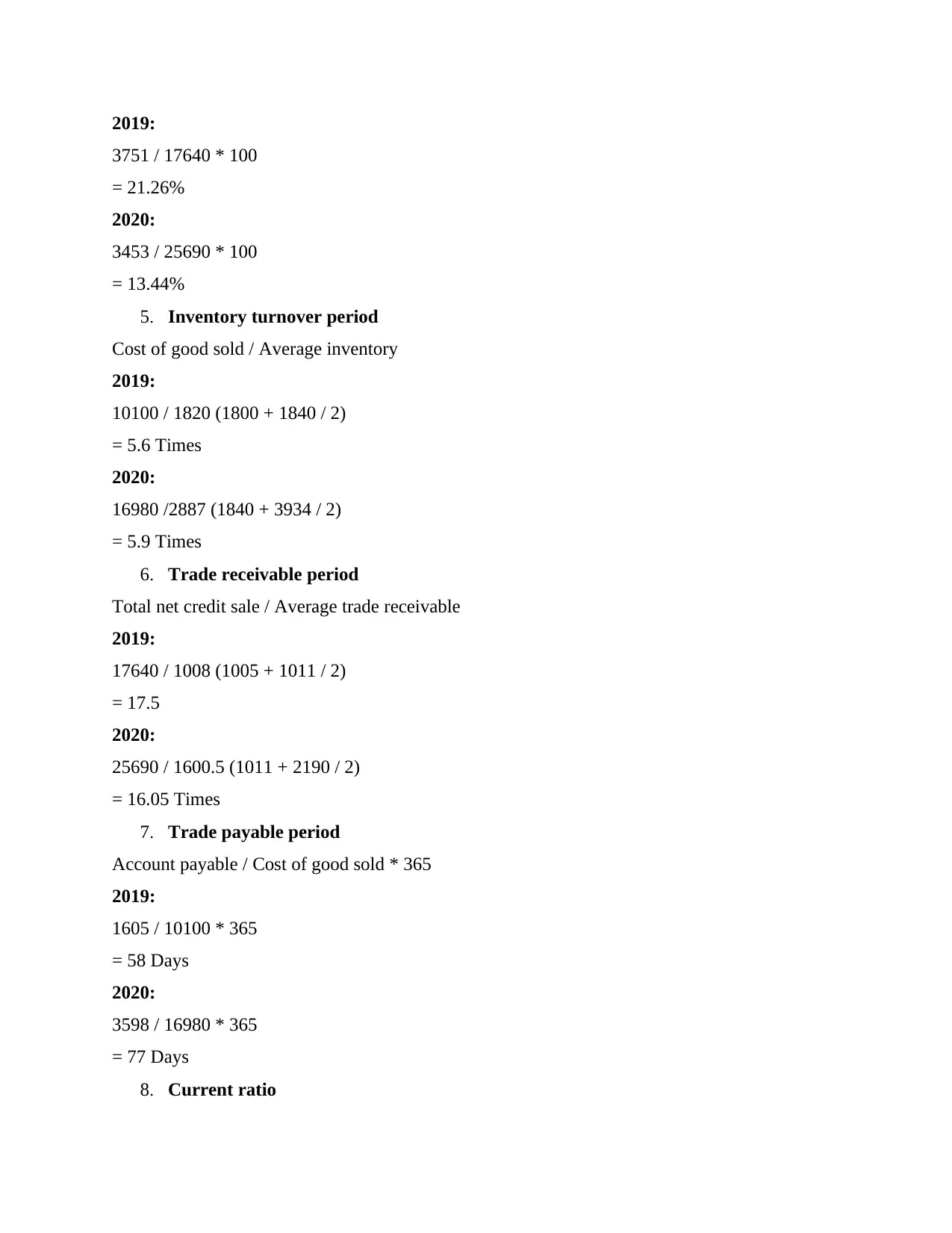
2019:
3751 / 17640 * 100
= 21.26%
2020:
3453 / 25690 * 100
= 13.44%
5. Inventory turnover period
Cost of good sold / Average inventory
2019:
10100 / 1820 (1800 + 1840 / 2)
= 5.6 Times
2020:
16980 /2887 (1840 + 3934 / 2)
= 5.9 Times
6. Trade receivable period
Total net credit sale / Average trade receivable
2019:
17640 / 1008 (1005 + 1011 / 2)
= 17.5
2020:
25690 / 1600.5 (1011 + 2190 / 2)
= 16.05 Times
7. Trade payable period
Account payable / Cost of good sold * 365
2019:
1605 / 10100 * 365
= 58 Days
2020:
3598 / 16980 * 365
= 77 Days
8. Current ratio
3751 / 17640 * 100
= 21.26%
2020:
3453 / 25690 * 100
= 13.44%
5. Inventory turnover period
Cost of good sold / Average inventory
2019:
10100 / 1820 (1800 + 1840 / 2)
= 5.6 Times
2020:
16980 /2887 (1840 + 3934 / 2)
= 5.9 Times
6. Trade receivable period
Total net credit sale / Average trade receivable
2019:
17640 / 1008 (1005 + 1011 / 2)
= 17.5
2020:
25690 / 1600.5 (1011 + 2190 / 2)
= 16.05 Times
7. Trade payable period
Account payable / Cost of good sold * 365
2019:
1605 / 10100 * 365
= 58 Days
2020:
3598 / 16980 * 365
= 77 Days
8. Current ratio
⊘ This is a preview!⊘
Do you want full access?
Subscribe today to unlock all pages.

Trusted by 1+ million students worldwide
1 out of 18
Related Documents
Your All-in-One AI-Powered Toolkit for Academic Success.
+13062052269
info@desklib.com
Available 24*7 on WhatsApp / Email
![[object Object]](/_next/static/media/star-bottom.7253800d.svg)
Unlock your academic potential
Copyright © 2020–2025 A2Z Services. All Rights Reserved. Developed and managed by ZUCOL.





